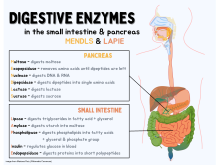This article needs additional citations for verification. (December 2016) |

Digestive enzymes take part in the chemical process of digestion, which follows the mechanical process of digestion. Food consists of macromolecules of proteins, carbohydrates, and fats that need to be broken down chemically by digestive enzymes in the mouth, stomach, pancreas, and duodenum, before being able to be absorbed into the bloodstream.[1] Initial breakdown is achieved by chewing (mastication) and the use of digestive enzymes of saliva. Once in the stomach further mechanical churning takes place mixing the food with secreted gastric acid. Digestive gastric enzymes take part in some of the chemical process needed for absorption. Most of the enzymatic activity, and hence absorption takes place in the duodenum.[2][3]
Digestive enzymes are found in the digestive tracts of animals (including humans) and in the tracts of carnivorous plants, where they aid in the digestion of food, as well as inside cells, especially in their lysosomes, where they function to maintain cellular survival.[4][5]
Digestive enzymes are classified based on their target substrates: lipases split fatty acids into fats and oils;[6] proteases and peptidases split proteins into small peptides and amino acids;[7] amylases split carbohydrates such as starch and sugars into simple sugars such as glucose,[8] and nucleases split nucleic acids into nucleotides.[9]
- ^ Patricia, Justin J.; Dhamoon, Amit S. (2024). "Physiology, Digestion". StatPearls. StatPearls Publishing.
- ^ "22.10C: Digestive Processes of the Small Intestine". Medicine LibreTexts. 2018-07-22. Retrieved 2023-08-14.
- ^ Heda, Rajiv; Toro, Fadi; Tombazzi, Claudio R. (2024). "Physiology, Pepsin". StatPearls. StatPearls Publishing.
- ^ Freund, Matthias; Graus, Dorothea; Fleischmann, Andreas; Gilbert, Kadeem J; Lin, Qianshi; Renner, Tanya; Stigloher, Christian; Albert, Victor A; Hedrich, Rainer; Fukushima, Kenji (2022-05-23). "The digestive systems of carnivorous plants". Plant Physiology. 190 (1): 44–59. doi:10.1093/plphys/kiac232. ISSN 0032-0889. PMC 9434158. PMID 35604105.
- ^ "Enzymes: What Are Enzymes, Pancreas, Digestion & Liver Function". Cleveland Clinic. Retrieved 2023-08-14.
- ^ "Lipase | Fat-digesting, Pancreatic, Lipolytic | Britannica". www.britannica.com. Retrieved 2023-08-14.
- ^ "Proteolytic enzyme | Description, Types, & Functions | Britannica". www.britannica.com. Retrieved 2023-08-14.
- ^ "3.3: Digestion and Absorption of Carbohydrates". Medicine LibreTexts. 2017-06-14. Retrieved 2023-08-14.
- ^ "Pancreatic nucleases - Big Chemical Encyclopedia". chempedia.info. Retrieved 2023-08-14.